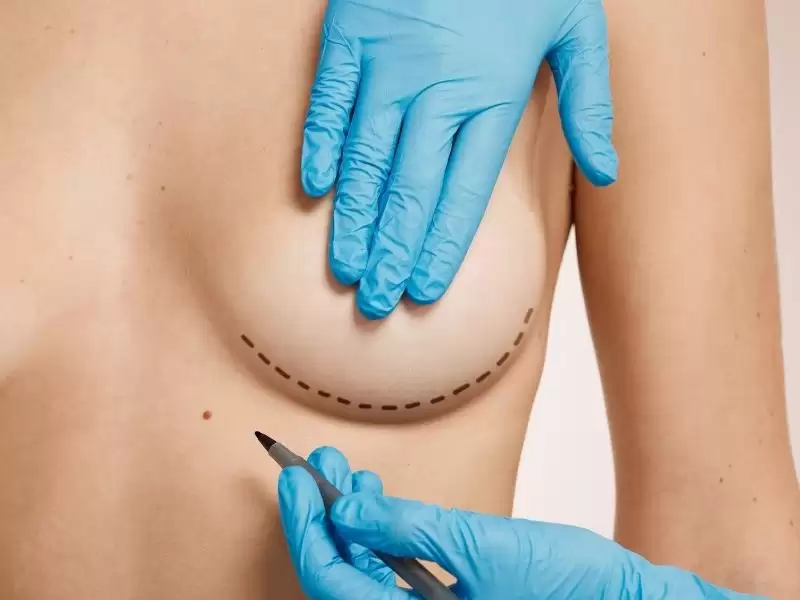What Is Gynecomastia?
Gynecomastia is the enlargement of the male breast tissue, similar to that seen in women. Since gynecomastia can develop due to various causes, different treatment approaches may be applied. Depending on the pattern of breast enlargement and the elasticity of the skin, several surgical methods are available. If the enlargement is caused only by glandular tissue or fat accumulation, the problem can often be resolved with minimal or no visible scarring. However, if there is excess skin or sagging, it may be necessary to remove some of the skin, which requires additional incisions. This may result in thin, line-shaped scars. These details are discussed thoroughly with the patient, and consent is obtained regarding the location of any incisions to be made. Typically, incisions are made around or through the areola, under the breast, or along its edges, depending on the chosen surgical technique.
What Causes Gynecomastia?
The primary cause of gynecomastia is hormonal imbalance. Conditions that lead to hormonal changes include certain health problems, medication use, alcohol consumption, or drug use. These factors can decrease testosterone levels while increasing estrogen levels in the body, and this hormonal shift can result in gynecomastia. In newborns, enlarged breasts may be observed due to estrogen passed from the mother during pregnancy. This usually resolves spontaneously within the first month after birth. In adolescence, gynecomastia is also common and tends to disappear within about two years in most cases. Among adults, it has been reported that one in four men between the ages of 50 and 69 experience gynecomastia. Health conditions that can cause gynecomastia include tumors, hyperthyroidism, kidney failure, liver failure, and pituitary gland insufficiency. Medications that may cause gynecomastia include drugs used in prostate cancer treatment, anti-anxiety medications, certain chemotherapy agents, and some heart medications.
What Are the Effects of Gynecomastia?
The enlargement of the breast tissue in men due to gynecomastia can lead to self-confidence issues and psychological distress. Many men may become introverted because of gynecomastia, and posture problems can develop as a result of trying to hide the chest area. Clothing choices may also be affected, as men often prefer to wear loose-fitting clothes to conceal their condition. While gynecomastia does not pose a direct health risk, it can cause significant emotional discomfort. Feelings of embarrassment or shame about breast enlargement may lead men to avoid swimming, sports activities, or other social situations. Therefore, treatment is often sought for psychological and cosmetic reasons rather than medical necessity.
How Is Gynecomastia Diagnosed?
Gynecomastia can be identified by swelling of the breast tissue and tenderness in the chest area. Some patients may also experience pain. When the male breast appears enlarged and resembles that of a woman — even when wearing clothes — it is often a clear sign of gynecomastia. True gynecomastia occurs due to the growth of glandular and fatty tissue in the breast, while false gynecomastia (pseudogynecomastia) results from excess fat accumulation without glandular enlargement. In pseudogynecomastia, the breast feels soft and is more common in overweight men. True gynecomastia, on the other hand, has a firmer, glandular texture similar to female breast tissue, and a specialist examination is required to determine which type is present.
How Is Gynecomastia Treated?
In most cases of gynecomastia, the main problem is the excessive fatty tissue within the breast. In such situations, liposuction performed through a small incision can provide the desired result. If glandular tissue removal is necessary, 1–2 cm incisions may be made to excise the excess tissue. For patients with excess skin, skin-tightening procedures may also be required. In these cases, surgery is typically performed around the areola, following the principle of leaving the smallest possible scar.
Male breast reduction surgery can be performed under general anesthesia or with local anesthesia combined with sedation. The average duration of the operation is approximately one hour, depending on the extent of the procedure. Hospitalization is usually not necessary, and patients can return to their daily activities on the same day. Most can resume work within a few days. After the procedure, it is recommended to wear a compression garment for about three weeks to support proper healing and maintain the new chest contour.
Gynecomastia Treatment
The treatment of gynecomastia varies depending on the degree and underlying cause of breast enlargement. In advanced cases, surgery may be necessary. The presence of scarring after gynecomastia surgery depends on the severity of the condition. In mild and moderate cases, scarring is usually minimal or barely noticeable, while in more advanced cases with significant sagging, small incision marks may remain around or extending from the areola if required. With the laser liposuction method, successful results can be achieved even in early- and mid-stage gynecomastia cases — and in some cases that would otherwise require excisional surgery. Since this method also provides skin tightening, the procedure can be performed through tiny 2–3 mm incisions. These small marks later become virtually invisible. Today, many cases of gynecomastia can be effectively treated with laser lipolysis, allowing patients to achieve the desired results with almost no visible scarring.
Gynecomastia Surgery Prices
The cost of gynecomastia surgery is determined based on the condition of the male breast tissue. First, the male chest area is examined to assess the type and extent of enlargement and to identify the underlying cause.
If you would like to learn more about male breast reduction, you can click on the related link for detailed information.
Frequently Asked Questions About Male Breast Reduction (Gynecomastia)
Does gynecomastia go away on its own?
Gynecomastia can resolve on its own in most infants or adolescents within a certain period. In cases where it does not go away spontaneously, a treatment plan may be created.
Does gynecomastia affect sexuality?
Gynecomastia is the enlargement of male breast tissue. It does not directly affect sexual function, but due to the enlarged breast appearance, the individual may experience low self-confidence, which can indirectly impact sexuality.
Does exercising help gynecomastia go away?
When gynecomastia occurs, it’s important to consult a specialist and determine the cause. Exercise or home remedies are usually not effective in reducing gynecomastia.
What happens if gynecomastia is not treated?
Gynecomastia is not a health-threatening condition but can cause aesthetic concerns. Psychological distress due to body image issues may make treatment necessary.
Does gaining weight cause gynecomastia?
Overweight individuals may experience pseudo-gynecomastia caused by fat accumulation in the breast area due to overall body fat increase.






